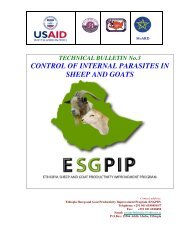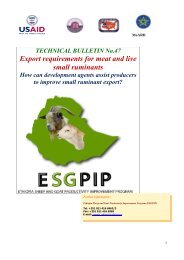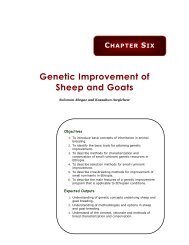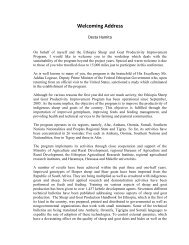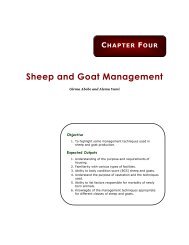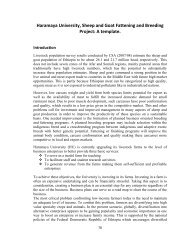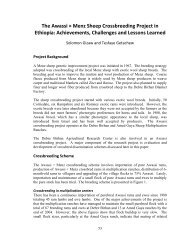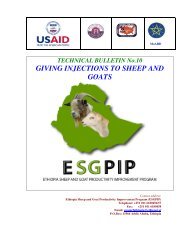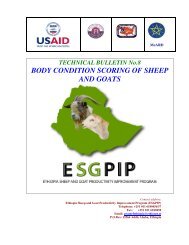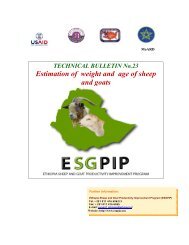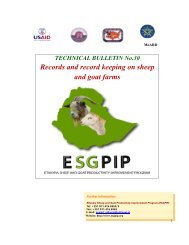TECHNICAL BULLETIN No.32 - esgpip
TECHNICAL BULLETIN No.32 - esgpip
TECHNICAL BULLETIN No.32 - esgpip
- No tags were found...
Create successful ePaper yourself
Turn your PDF publications into a flip-book with our unique Google optimized e-Paper software.
• Lambs and kids are, in some areas, kept in a dome made of bamboo or other locally availablematerial (Figure 1). This prevents the young from straying or mixing with the flock, exceptduring suckling. The dome is usually kept outdoors during the day if there is no rain.a. Yards without roofs b. Night shelters aroundAbergelle, Tigraic. A bamboo dome forlambs/kidsd. Dry season housing (Menz) e. Wet season housingbasementand human houseupper floor (Menz)f. Raised sheep/goathousing (north Gondar)g. Lamb shelter in Afar h. Adult (right) sheep shelter in AfarFigure 1. Night shelters under the traditional system2.2. Shortcomings of traditional housingTraditional sheep and goat shelters are usually poorly lit and have inadequate ventilation anddrainage (Figure 2). Housing sheep and goats within the family house can have seriousconsequences should an outbreak of zoonotic diseases (e.g., anthrax) occur. Diseases such as mangeand coccidiosis could be transmitted to children. Housing animals in close quarters also encouragesspread of external parasites, and bacterial and viral infections among animals.2
Figure 2. The inside of poorly lit, ventilated and drained animal houses3. Types / designs of recommended housing options3.1. Where to locate animal housing/shedsThe location of the house/shed is important for animal comfort and safety. Sheep and goat housingshould be built: On a well-drained area. Downwind from the owner’s house. Near to the family house to keep an eye on the animals but far enough to minimize smell (atleast 10 meters). On a floor 1-1.5 m above the ground should the area be waterlogged or prone to flooding.It is always wise to keep in mind the possibility of expansion when building housing for sheep andgoats. An appropriate flock development plan has to be made to anticipate future construction needs.3.2. OrientationThe orientation of the shed can be important depending on the climate. One can prevent the sun fromheating up the stall too much by placing the longitudinal axis of the stall east - west. If, on the otherhand, one wants the sun to shine on the floor so that the floor dries up and parasites die, it is better tobuild the shed along a north - south axis (This is preferred in humid areas).West-East orientationNorth-south orientationFigure 3. Orientation3
VentilationThe purpose of ventilation is to provide the desired amount of fresh air, without drafts, to all parts ofthe shelter; to maintain temperatures within desired limits; and to maintain ammonia levels belowspecified levels. Ventilation is of utmost importance to maintain a desirable interior temperature of28 to 30°C. If the animals cannot get rid of heat because the surrounding temperature is too high(above 30°C), they eat less and therefore produce less. Majority of pneumonia cases can be traced toexcessively warm and humid interior and sudden changes in temperature. It is, therefore, necessaryto make the shed sufficiently high and make sure there are openings for ventilation in the roof orwalls. It is essential to note that ventilation is good, but draughts are bad! The ventilation openingsmust, therefore, be placed high enough so that air does not blow directly past the animals (draught).In warm climates, where the stalls are fairly open, a low wall of about 1 meter on the side the windcomes from is sufficient.Figure 4. Ventilation in stall3.3. Materials for building an animal barnSheep and goat barn construction need not be complicated or expensive. The materials used inconstruction should be those locally available that will result in a long-lasting structure. Animalsafety and welfare is very important in the design and construction of housing.3.4. Type of housingThere is no one, single blueprint for housing; choose the form that best suits your situation. Build thestructure so that sheep and goats can easily live, eat and rest. Make sure that you can work therecomfortably.Housing requirements are more or less the same for sheep and goats. The type of housing built willvary depending on the type of production system, size of operation and environmental conditions. Interms of sophistication, animal housing can range from very simple structures made only of a roofand no walls to complex structures with solid walls fitted with automatic ventilators, feeders andwaterers.Animal housing in tropical and semi-tropical regions should be kept to a minimum except forintensive production systems. In the arid tropics, no protection other than natural shade may berequired. In humid climates, a simple thatched shelter will provide shade and protection fromexcessive rain.4
Figure 5. A well designed simple set up of a sheep farm with paddocksFigure 6 is a close up of the shed with the roof left out to show the inside better.5
Figure 6. Lay out of the interior of a shedRoof: The roof provides protection from sun and rain and can be of a shed, gable or modified gablestyle (Figure 7). Slope is important in removing rain and thatched roofs need a greater slope thaniron sheeting. A greater slope is also beneficial in areas with high rainfall. The roof should bewaterproof with sufficient overhang to prevent rain from blowing in. Adequate ventilation isessential in maintaining animal health. A high roof encourages air movement but is more likely tobe damaged by strong winds. A roof vent can assist in proper ventilation. Roofs can be constructedfrom iron sheet, grass/bushes, wood, stone/brick or earth depending on production system, materialavailability and climate.Shed Gable Modified GableFigure 7. Types of roofWall: The wall should not be completely solid to allow air movement through the house. Good airmovement (ventilation) is essential to remove moisture, excess heat in hot weather and/or odor andgasses from animal waste so that animals stay cool, dry and clean. Inadequate ventilation can lead toproblems such as pneumonia. While good ventilation is essential for animal health, drafty conditionsmust be avoided. Air circulation should be above the animals’ heads and ventilation openingsshould be placed high enough so that air does not blow directly past the animals. Air movement canbe effected through mechanical (e.g., ventilator) or natural means. Providing openings or short side6
walls of about 1 meter height will provide sufficient ventilation. A hedge can also fulfill thisfunction.Outer walls are designed to protect animals from external influences and inner walls aid in animalmanagement, such as controlling breeding. At a minimum, inner walls should create pens for: Males Females with young Females without youngOther pens to consider building are those for weaned young, young males of breeding age, youngfemales of breeding age, and an isolation pen for sick animals. A paddock or yard alongside theshed where animals can exercise and be fed and watered can also be built.Generally, animals are separated based on their physiological status. Partitioning a sheep/goat barnhas the following advantages:• It is easier to feed different classes of animals according to their needs.• It is easier to follow a mating schedule.• It is easier to control breeding and, thus, prevent inbreeding and mating at a very early age.• Lactating animals can look after their young better and pregnant animals can give birth undera more relaxed environment.• Sick animals can be isolated; thus, reducing the risk of disease dissemination.At a minimum, barns should have separate pens for adult males, young males, pregnant females, andyoung weaned offspring. If the herd is large and space is available, additional pens should beconstructed for:• Weaned male lambs/kids of the same size should be penned together and not mixed withyounger, smaller animals unable to compete for feed;• Pregnant females close to parturition should be penned separately from nursing females,young females not bred yet and adult males;• Partitions for adult male pens should be high enough so that males cannot jump out toprevent unintended mating;• Whereas small barns may not need an aisle between pens, particularly in large barns, a centeraisle makes many management practices easer; such as sorting animals, feeding, monitoringbreeding, etc. It also facilitates movement of workers in the barn.Floor: The floor could either be packed earth, concrete or slatted (Figures 8 and 9). Packed earth orconcrete floors should have a slope of about 5% for good drainage. Raised platforms where sheepand goats can lie above the floor and away from manure and urine are beneficial. These can beplaced along the longest wall of the barn.7
Slatted floors should be raised about 1-1.5 meters above ground level to facilitate easy cleaning andcollecting of dung and urine. The gap between the slats should be 1.4 to 1.6 cm to allow easypassage of fecal material and guarantee safe footing for the animals. Newborn and young lambsshould not be put on slatted floors. A piece of wood temporarily placed on the slats will prevent leginjury to very young lambs and kids. A raised, slatted floor in tropical and subtropical areas has thefollowing advantages:• No need of bedding• Allows manure, urine and debris to drop through the slatted floor, thus removing a majorsource of disease and parasite infestation• Requires less labor to clean and maintain• Remains relatively dry and clean• Reduced space requirements• Manure is easily collected for fertilizer use or for sale• Allows air to pass through the slats increasing ventilation and comfort in hot weather.The main disadvantage of raised, slatted floors is the high expense of construction. Some materials,such as bamboo, may be cheaper than wood but may provide less secure footing. For all but thesmallest barns, commercial wood is preferred to bamboo as it stronger and more long-lasting. Cost,ease of installation and safety must all be considered when selecting flooring material for a slattedfloor. Other concerns with slatted floors are leg and foot problems from too wide a gap or poormaintenance of existing slatted floors.Bamboo wooden Slats made of Eucalyptus twigsFigure 8. materials for constructing slatsFigure 9. A raised, slatted floor8
Space requirement:In any type of housing for sheep and goats, adequate floor space must be provided. Recommendedspace requirements vary depending on animal size and the type of floor used (Table 1). Adjustmentsmay also be made depending on local climate and flock size. Additionally for animals managedtotally indoors, an open yard for exercising is required. Sheep and goats should not be crowded andmust have room to lie down. Overcrowding promotes ill health.Table 1. Recommended floor space for sheep and goatsType of animal Weight (Kg) Floor Space (m²/animal)Solid Floor Slatted Floor Open yardEwe/ doe 35 0.8 0.7 2Ewe/ doe 50 1.1 0.9 2.5Ewe/ doe 70 1.4 1.1 3Lamb/ kid 0.4 – 0.5 0.3 – 0.4Ram/ buck 3.0 2.5Pregnant ewes/does 2.0 1.53.5. Recommended housing optionsThe kind of house and equipment will depend upon the particular kind of sheep/goat enterprise andthe climatic conditions under which it must be operated. Below are examples of housing types fordifferent production systems and agro-ecologies.3.3.1 Production systemsSmallholder producer: Smallholder producers with few animals are characterized by low input,low output production systems where costs need to be kept to a minimum. Cost reduction techniquessuch as making the animal shelter attached to the main house (lean-to house) (Figure 10); usinglocally available, inexpensive materials; or, depending on the climate, providing minimum shelter(e.g., open yards) need to be considered. Designing animal houses for multipurpose use, such asincluding roof space to store farm implements, feed, seed, etc., (Figure 11) is one way of reducingthe cost of housing sheep and goats. Thatched roof houses are often adequate.Figure 10. A lean-to house9
Figure 11. Traditional sheep/goat houses with roof space to store seeds and farm implements.Small scale commercial producers: Small scale commercial farmers produce sheep and goatsfrom a business perspective and require improved management than that of smallholder producers.Basic requirements for good sheep and goat housing must be followed with the size of the barncommensurate with the number of animals expected to be raised. In dry areas, a house with a packedearth floor can be used since moisture buildup within the house would be minimal. In humid areas, araised floor house (Figure 12) is advisable to keep animals clean and facilitate waste removal. Thetype of wall (open, semi open, closed) and type and height of roofing should be made according toprevailing local climate.Figure 12. Raised houses of thatched roof (left) and corrugated iron sheet roof (right)10
OutsideFigure 13. Goat house planInsideFigure 14. Plan for small scale farmers having 40 adult sheep or goats showing dimensions.Large scale commercial producers: Large scale commercial sheep and goat production requiresmore elaborate housing than those of small scale producers (Figures 15 and 16). Large scaleproducers may have several different barns for different types of animals:• Breeding ewes• Breeding males• Growing and fattening lambs after weaning• Weaned young• isolation pen for sick animals• Hay storage shed (figure 13)• Storehouse for concentrates11
Central alley and feeding trough on both sides of the alleyFigure 15. Floor plan (left) and a house (right) for a large scale production.Figure 16. A slatted floor, semi-open barn with feeding trough and a central alleyFigure 17. A large, raised sheep/goat house for a commercial flock/herd12
Proper space allowances should be followed for expected numbers of animals in a pen, animal sizeand whether an open yard is available. Building dimension and orientation will vary according toflock size and local environmental condition. In hot, humid conditions, long, narrow houses mayfacilitate removal of heat and moisture.Feed storage facilities are important on large scale farms. Shed size should be determined based onthe amount of feed to be stored. A general guide for grass hay and straw storage is given in Table 2.Table 2. Space requirement for a feed storage shedType of feed Loose Baled Choppedm 3 /ton kg/ m 3 m 3 /ton kg/ m 3 M 3 /ton kg/ m 3Non-legume 13-17 70-53 7-9 130-95 8.5-11 105-80hayStraw 19-28 48-30 11-14 80-65 7-10 130-115Source: Hinch and Lynch. (Undated).3.3.2. Agro-ecologyHighland: Most highland areas are characterized by high rainfall and low temperature. Under theseconditions, houses with raised floors, gable roofs with sufficient overhang to protect from blowingrain and solid lower walls are suitable. The upper portion of walls should allow air movement toprovide sufficient ventilation. Both sheep and goats are susceptible to pneumonia if houses are dampand poorly ventilated. In some highland areas where the rainfall is low, a well-drained packed earthor concrete floor can be used.Mid-altitude: In mid-altitude areas where the climate is humid, houses with raised floors or onstilts provide a numerous advantages. Ventilation is good and dung and urine drops through theslatted floor minimizing parasite and disease problems. In drier areas, packed earth or concrete canbe used providing they are kept clean and barn ventilation is sufficient to keep walls and floors dry.Lowland: Ethiopian lowlands are mainly arid and semiarid areas with hot temperature for most ofthe year. Most pastoral and agro-pastoral production systems are found in these areas. Traditionally,sheep and goat housing consists of open yards for nighttime enclosures. Natural shade from trees andshrubs provides protection against intense heat during the day (Figure 18). More elaborate animalhousing for intensive and semi-intensive production requires partially covered long walls withroofing made of materials which do not create hot conditions beneath them at high ambienttemperatures. Packed earth would be as suitable as slatted floors under this condition since moisturebuildup is very low.13
Figure 18. Sheep staying under a tree shade during the hot part of the day4. SummaryProductivity of sheep and goat is influenced by the type of shelter provided. There are varioushousing and floor designs that can be used depending on the production system employed and localclimate. Cost of construction, ease of cleaning, proper ventilation and drainage, and adequatelighting are important aspects to be considered in designing a house. Inner pens are needed for largeflocks for proper handling and management, particularly controlled breeding. Proper handling ofmanure needs attention since it has health and economic benefits.5. Messages to Development agents• Should understand the role correct housing plays in improving overall animal productivityand advise farmers/pastoralists accordingly.• Advise farmers/pastoralists on types of housing suitable for the area and scale of production.• Should know and advise large scale farmers on the importance of holding pens and theirdesign.• Should know and advise farmers/pastoralists on how to handle and utilize manure.6. ReferencesSteele, M. 1996. Goats. Costa, R. and Smith, A.J. (eds). Tropical Agriculturalist, Technical Centerfor Agricultural and Rural Co-operation (ACP-EU), Wageningen, The Netherlands. pp.152.Hinch, G.N. and Lynch, J.J. Undated. Comfortable quarters for sheep and goats. Department ofAnimal Science, University of New England, Armidale, Australia.14



